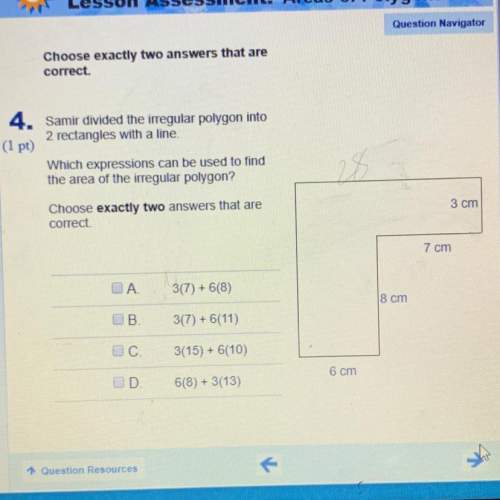
Mathematics, 28.10.2019 23:31 jenna34032
The number of times that a person contracts a cold in a given year is a poisson random variable with parameter λ = 5. suppose that a new wonder drug (based on large quantities of vitamin c) has just been marketed that reduces the poisson parame- ter to λ = 3 for 75 percent of the population. for the other 25 percent of the population, the drug has no appreciable effect on colds. if an individ- ual tries the drug for a year and has 2 colds in that time, how likely is it that the drug is beneficial for him or her?

Answers: 1


Another question on Mathematics

Mathematics, 21.06.2019 16:00
Brent needs to paint a logo made using two right triangles. the dimensions of the logo are shown below. what is the difference between the area of the large triangle and the area of the small triangle? (1 point) select one: a. 4.5 cm2 b. 8.5 cm2 c. 16.5 cm2 d. 33.0 cm2
Answers: 1

Mathematics, 21.06.2019 18:40
Some boys and girls were asked if they had a pet. one third of the group were boys. there were 20 boys. 20% of the girls had a pet. boys with a pet : girls with a pet = 1 : 5 i need to know how many girls there are.
Answers: 3

Mathematics, 21.06.2019 20:30
Lola says these two expressions have the same value. expression a expression b which explains whether lola is correct?
Answers: 2

Mathematics, 21.06.2019 21:30
In a test for esp (extrasensory perception), the experimenter looks at cards that are hidden from the subject. each card contains either a star, a circle, a wave, a cross or a square.(five shapes) as the experimenter looks at each of 20 cards in turn, the subject names the shape on the card. when the esp study described above discovers a subject whose performance appears to be better than guessing, the study continues at greater length. the experimenter looks at many cards bearing one of five shapes (star, square, circle, wave, and cross) in an order determined by random numbers. the subject cannot see the experimenter as he looks at each card in turn, in order to avoid any possible nonverbal clues. the answers of a subject who does not have esp should be independent observations, each with probability 1/5 of success. we record 1000 attempts. which of the following assumptions must be met in order to solve this problem? it's reasonable to assume normality 0.8(1000), 0.2(1000)%30 approximately normal 0.8(1000), 0.2(1000)% 10 approximately normal srs it is reasonable to assume the total number of cards is over 10,000 it is reasonable to assume the total number of cards is over 1000
Answers: 1
You know the right answer?
The number of times that a person contracts a cold in a given year is a poisson random variable with...
Questions












Spanish, 05.12.2019 20:31











